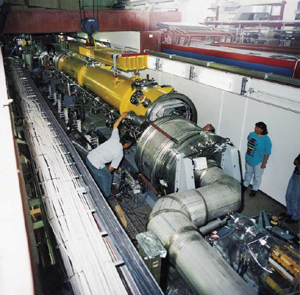
In a major boost for future plans, an international team based at DESY has achieved maximum light amplification from a free-electron laser (FEL) for ultraviolet radiation. The amplification of 10 million is the theoretically expected peak performance for such a device and is over a thousand times the brightness so far achieved in this region of the electromagnetic spectrum.
The FEL at DESY produces ultraviolet light with wavelengths of between 80 and 180 µm – the shortest wavelengths produced in this way. Maximum light amplification (“saturation”) was obtained with a wavelength of 98 µm.
The latest results were produced at DESY’s TESLA Test Facility (TTF) using the self-amplified spontaneous emission principle (SASE), first proposed and investigated elsewhere in the early 1980s. In SASE, electrons brought to high energies in a suitable accelerator subsequently traverse a slalom-like course of magnets, emitting laser-like bundles of radiation as they do so.
The electrons and the emitted radiation act on each other. The tiny bunches of electrons try to match the wavelength of the radiation, thereby becoming denser and radiating more intensely. This microbunching continues until all of the electrons oscillate in unison. Unlike traditional lasers, the SASE approach is not limited to specific wavelengths and it can be scaled appropriately.
The SASE FEL at DESY has shown for the first time that the self-amplifying effect does lead to the theoretically calculated amplification in the ultraviolet regime. Similar amplification factors were demonstrated last year at institutes in the US in the visible light range (500 µm).
Soon, the existing DESY TTF will be upgraded to a 300 m FEL to attain wavelengths of less than 6 µm – the regime of soft X-rays. As well as a research facility in its own right, it will serve as a testbed in the international TESLA project for a superconducting linear electron-positron collider. As well as supplying beams for particle physics research, this will also apply SASE technology to produce ever shorter wavelength X-rays.








